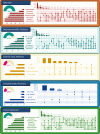Mapping Strategies to Assess and Increase the Validity of Published Disproportionality Signals: A Meta-Research Study
- PMID: 37421568
- PMCID: PMC10442263
- DOI: 10.1007/s40264-023-01329-w
Mapping Strategies to Assess and Increase the Validity of Published Disproportionality Signals: A Meta-Research Study
Abstract
Background and aim: Disproportionality analysis is traditionally used in spontaneous reporting systems to generate working hypotheses about potential adverse drug reactions: the so-called disproportionality signals. We aim to map the methods used by researchers to assess and increase the validity of their published disproportionality signals.
Methods: From a systematic literature search of published disproportionality analyses up until 1 January 2020, we randomly selected and analyzed 100 studies. We considered five domains: (1) rationale for the study, (2) design of disproportionality analyses, (3) case-by-case assessment, (4) use of complementary data sources, and (5) contextualization of the results within existing evidence.
Results: Among the articles, multiple strategies were adopted to assess and enhance the results validity. The rationale, in 95 articles, was explicitly referred to the accrued evidence, mostly observational data (n = 46) and regulatory documents (n = 45). A statistical adjustment was performed in 34 studies, and specific strategies to correct for biases were implemented in 33 studies. A case-by-case assessment was complementarily performed in 35 studies, most often by investigating temporal plausibility (n = 26). Complementary data sources were used in 25 articles. In 78 articles, results were contextualized using accrued evidence from the literature and regulatory documents, the most important sources being observational (n = 45), other disproportionalities (n = 37), and case reports (n = 36).
Conclusions: This meta-research study highlighted the heterogeneity in methods and strategies used by researchers to assess the validity of disproportionality signals. Mapping these strategies is a first step towards testing their utility in different scenarios and developing guidelines for designing future disproportionality analysis.
© 2023. The Author(s).
Conflict of interest statement
The authors declare no conflict of interest specific for this research.
Figures

References
-
- Raschi E, Moretti U, Salvo F, Pariente A, Antonazzo IC, Ponti FD, et al. Evolving roles of spontaneous reporting systems to assess and monitor drug safety. In: Kothari CS, Shah M, Manthan Patel R, editors. Pharmacovigilance. IntechOpen; 2018; https://www.intechopen.com/online-first/evolving-roles-of-spontaneous-re.... Accessed 3 Feb 2019.
-
- Fusaroli M, Simonsen A, Borrie SA, Low DM, Parola A, Raschi E, et al. Identifying medications underlying communication atypicalities in psychotic and affective disorders: a pharmacovigilance study within the FDA Adverse Event Reporting System. J Speech Lang Hear Res. 10.1101/2022.09.05.22279609. (in press). - PubMed
Publication types
MeSH terms
LinkOut - more resources
Full Text Sources
Medical

